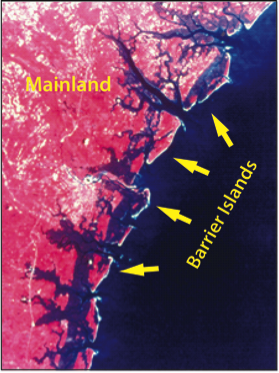Mixed-Energy Barriers
Mixed-energy barrier island systems are typically short and wider at one end than the other end. Historically, this type of morphology has been referred to as a drumstick barrier island because of its approximate similarity in shape to the drumstick of a chicken leg. The tidal inlets between these barriers are large because of the relatively higher tidal energy. Compared to wave-dominated barriers, they also have large ebb-tidal deltas because the strength of the tidal currents is able to transport sediment seaward in a regime of relatively low wave energy. The relatively wider end of the island is the result of the accretion of sediment as waves refract around the edge of the ebb-tidal delta, causing a localized reversal in the longshore transport pattern and leading to sand accumulation.

